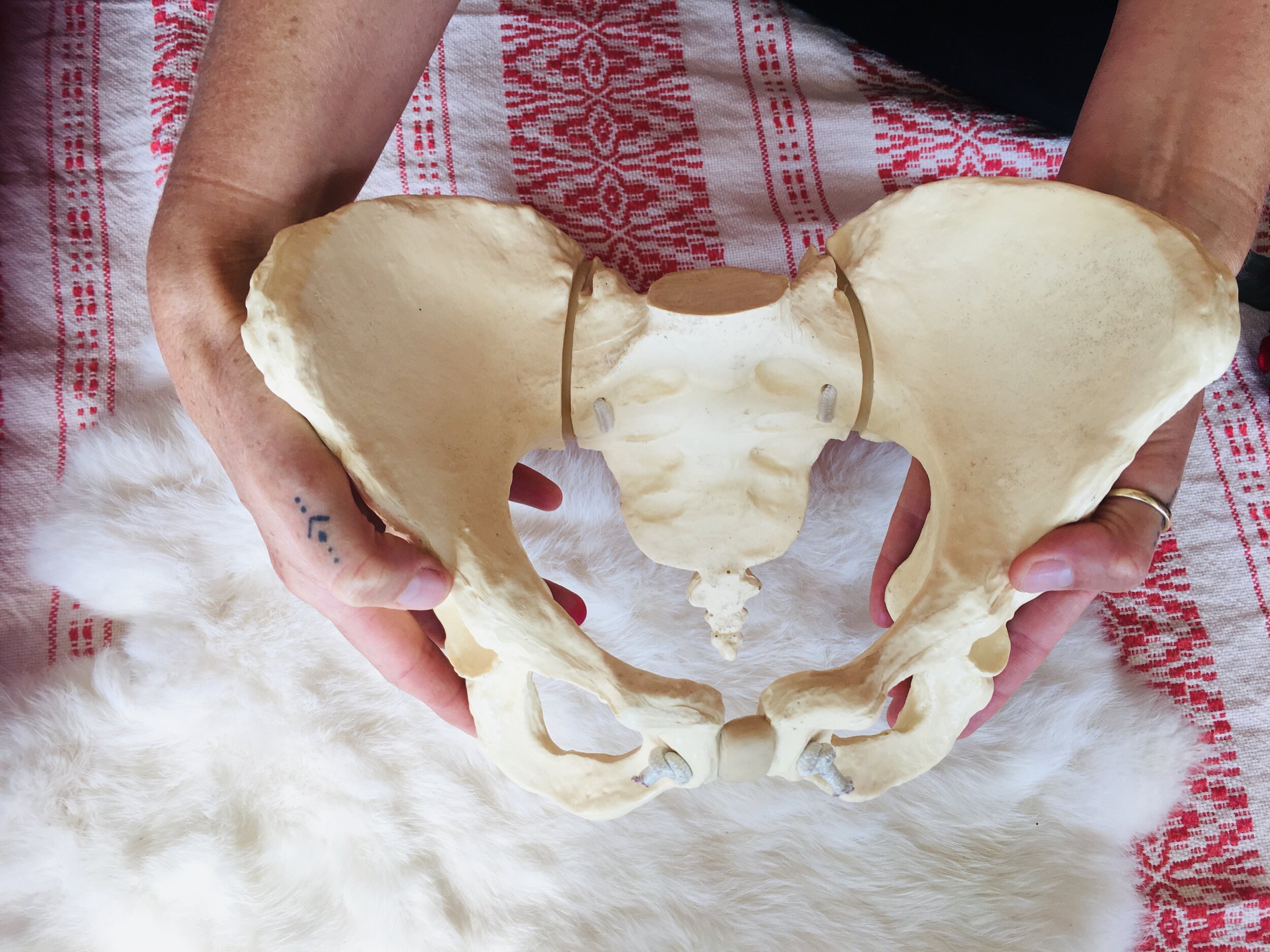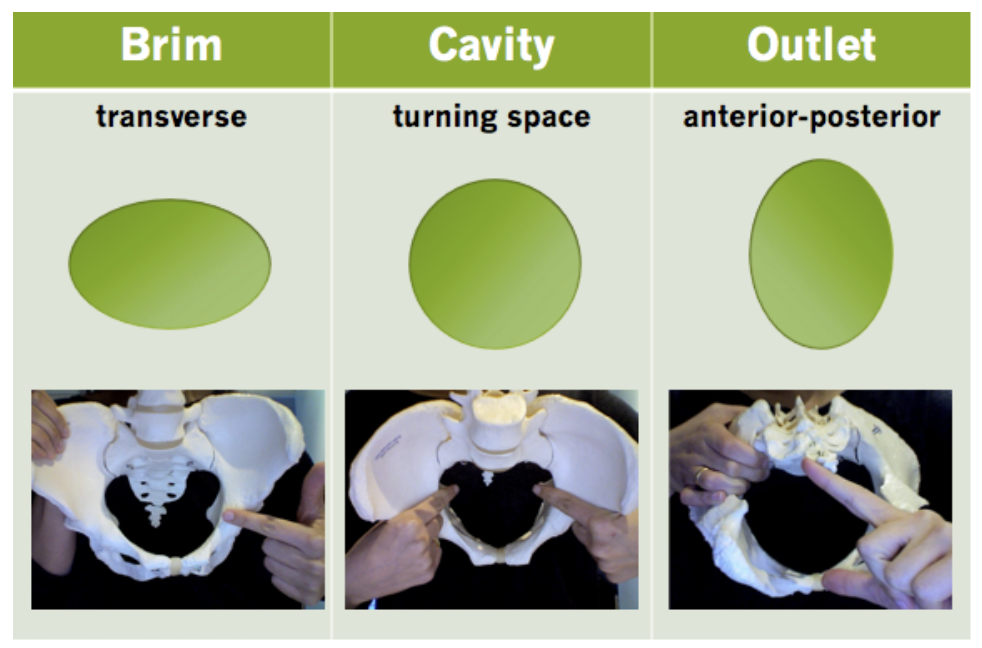The Extraordinary Bony Pelvis
Article for Natural parent magazine, Article 3 of 12 in the Clever body series.
The following article exploring the extraordinary bony pelvis is part three in a series of twelve that will explore some of the main pelvic ligaments and structures that have a role in our reproductive wellbeing, and in creating comfort in pregnancy and ease in birth. This series of articles will explore the anatomy of the varying structures, discuss how the structures change in response to pregnancy and the postnatal period, discuss how the structures might affect comfort in pregnancy and ease in birth and also investigate and discuss ways to lovingly and gently support these structures so alignment, balance and comfort are optimised.
Our bony pelvis houses our precious pelvic organs as well as providing stability, weight bearing, balance and centering for the rest of the body. The bony pelvis is often what is first thought of when we think about the baby moving though the pelvis. Although the bony pelvis is ‘ bone’ it is important to remember that it is incredibly malleable and has a lot of movement and flexibility. Women are often told or given the message that somehow their female bodies are broken. We are ‘to fat’, ‘to skinny’ , ‘to short’, ‘to tall’ , ‘to hairy’ etc. I have heard many women tell me they have been told their pelvis is ‘twisted’ or ‘to small’ or ‘out of alignment’ Most of us have a pelvis that is asymmetrical. Our bodies are asymmetrical – we have a liver on the right and a spleen on the left, our heart sits more to our left side and one kidney is higher than the other. Rather than finding fault with our bodies how might it be to approach our incredible bodies with kind compassion, with a faith in their abilities and an approach that aims to improve comfort and ease. How liberating it could be to invite space rather than to ‘fix something that is ‘broken’.
The bony pelvis is made up of 4 main bones, the sacrum (formed of 5 fused vertebrae) the coccyx ( formed of 4 fused vertebrae) and the 2 ‘hip bones’ ( which are made up of the lilium, the ischium and the pubis, these 3 bones fuse together at around 16 yrs. of age). Women pelvis’s are shaped to allow our babies though. The pelvis has been spoken about as fitting in 4 groups of shapes, gynaecoid, android, platypelliod and anthropoid. Interestingly however much of the information on pelvic structures came from research on cadavers. Living people, unlike living cadavers, have a lot more room, variety and movement in their pelvis. The space within the pelvis bones is also affected by the soft tissues, ligaments, muscles and fascia. Spinning Babies ® suggests that it is the soft tissues of their pelvis that determine the Babies position and it’s the bony pelvis that determines whether or not this position matters.
Image 2 source: http://encyclopedia.lubopitko-bg.com/Pelvic_Girdle.html
In the front centre of the pubic bone is the symphysis pubis. A deliciously thick ligament that holds the 2 hip bones together . Just like the sacral-iliac joints the symphis pubis is very strong but also malleable. For some women this ligament can become super soft and hyperflexible which can cause pain and discomfort (symphysis pubis dysfunction).
When this happens it is important to try and keep ones knees together, to strengthen the muscles of then inner thigh, to move gently and also ‘penguin’ walking can be helpful also. Seeing an experienced Craniosacral therapist, osteopath, physiotherapist, acupuncturist or trusted health care provider can also be useful. This link may be useful for further information and a link to Smiley belts also https://smileybelt.co.nz/understanding-symphysis-pubis-dysfunction/
The illium ‘hip bones’ are attached to the sacrum via the strong ligaments of the sacroiliac joints. This joint is very strong (it holds bones together) yet it is capable of lots of movement -sideways, up and down and diagonally. During pregnancy the hormones relaxain and progesterone help the ligaments soften ever more allowing approximately 30% more movement and space. When the birth giver is mobile and active even more space and movement can be created within the bony pelvis.
The sacrum is the door of the birth. The sacrum and the coccyx can both move sideways and extend outwards to allow the baby to come through the birth canal. Some pregnant people may also experience pain and discomfort in the sacrum and Sacro- iliac ( where the sacrum meets the lilium) as the ligaments that hold everything together soften.
Let your midwife or health care provider known. As well as body work osteopathy, craniosacral, physiotherapy, you could try:
Gentle hip circles
Gentle stretches
The Spinning babies® Three sisters of Balance™- This helps the soft tissues to find balance and comfort, however avoid side lying release if you are hypermobile.
Walking
Avoiding long periods of sitting
Avoiding repetitive asymmetrical movements or resting positions
The Spinning Babies ® Rest smart ™ https://spinningbabies.com/start/in-pregnancy/rest-smart/
Wearing footwear that helps comfort and balance for your body ( i.e. avoid high heels if you can)
Gentle yoga stretches
Smiley belt.
We think of our pelvic bone sitting straight up but actually the pelvic bone tilts forward – this is to allow our legs to hang down from our hip joints , my friend and fellow spinning Babies ® trainer Fiona Hallinan calls this ‘ the angle of the dangle’ . As you can see in this picture.
As the baby comes through the pelvis it has 3 levels to move and spiral though.
The inlet (brim) – which is wide side to side
The midpelvis (cavity) – which is the same all the way around and allows the baby the space to rotate and line up their heads to come out of the outlet.
The outlet – which is widest front to back.
Sometimes in labour a baby will be waiting at a certain part of the pelvis for more room to decent and be born. The inlet, midpelvis and outlet are all shaped differently and have different ways to move and different positions that help them to be most open with the most available space.
The inlet is already open from side to side so we can support it to open more from front to back .
The midpelvis can open in all directions.
The outlet is already open front to back but can open more side to side and diagonally .
The soft tissues , ligaments, muscles and fascia also affect the available space at all of the levels. Spinning Babies ® offers Three Level Solutions ™ which are practical , hands on and simple solutions to support the pelvis to open where the bay is waiting. The Three level solutions ™ may be useful when there is a ‘stall;’ or ‘lack of progress’ in labour.
Some example are:
Inlet - hip circles or an abdominal lift and tuck this increases the from to back space.
Midpelvis - Lift a leg up to help the create asymmetry and space in the midpelvis. (The midpelvis can move in all directions).
Outlet - bring your knees together ( internal rotation of the femurs) , try 1 leg up on a chair , or on a peanut ball or some pillows if lying on your side. (The outlet opens in all directions).
For a more detailed description, with some great pictures and solutions click onto this link.
I love pelvises, the bony bowl of our power and pleasure. I love the way they look, I love how they move, I love that babies pass through them. I love that they are so stable and also so flexible. I hope you are able to find ways to invite more comfort , ease and pleasure into your pelvis.
Image source : https://www.corebodywisdom.com/what-is-sri





